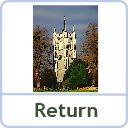Vicars and Lecturers
Between the choir vestry and the north door is a panel in memory of Canon F.G. Given-Wilson, Vicar from 1906 to 1950, which records the names of Vicars since 1322 and Lecturers since 1577. This was designed and executed by Caröe. Many people are puzzled by the term "Lecturer" .
Before the Reformation, the parish clergy in England were not trained to preach sermons, which were provided by itinerant friars and Lollards. When King Henry VIII suppressed the religious houses these were no longer available. Within the next thirty years or so many towns and parishes hired "Town Preachers" or Lecturers to fill the gap. Dr Samuel Johnson in his famous Dictionary of the English Language of 1755 gives an extra definition of the word Lecturer: "A preacher hired by a parish to assist the rector or vicar" . This shows clearly that this office must have been quite common. Here in Dedham the first Lecturer was appointed in 1577. His pastoral duties included delivering sermons (synonymous with Lectures) on Sunday afternoons, when he instructed the young, and Tuesday mornings at eight o'clock before the wool-market on which Dedham's prosperity very largely depended.
There are monuments in the sanctuary and the chancel to the first two Lecturers and to the Reverend William Burkitt. Matthew Newcomen, the third Lecturer, who was appointed following the death of John Rogers, was a particularly interesting man. Educated at Colchester Royal Grammar School and St John's College, Cambridge, he was appointed Lecturer in 1636 at the age of twenty-six. Only five years later he was called to preach to the House of Commons at St Margaret's, Westminster, and this was repeated on a number of subsequent occasions. He held staunchly Puritan views and was joint author of the well-known pamphlet SMECTYMNUUS. After the Restoration King Charles II offered to some ten or twelve Puritan Divines the position and honour of Chaplain to the King. Newcomen alone refused.
In 1661 he was a member of the Royal Commission appointed by the King in an endeavour which sadly failed to bridge the gap between the Puritans and Bishops. The following year the Royal Assent was given to the Act of Uniformity. Neither Newcomen nor George Smith the Vicar could bring themselves to sign the necessary declaration, so, on St Bartholomew's Day (24 August) 1662, both were debarred from the Ministry of the Church of England. Newcomen had married a widow of means and built a house which was later bought from his family by the Reverend William Burkitt and given as a residence for future holders of the office to be known as the "Lecturer's House" . Later, in 1662, Matthew Newcomen accepted an invitation to Leyden in Holland to minister to the English community there. Sadly, in September 1669 he fell victim to the plague and was buried in an unmarked grave.
In the years succeeding 1662, times in Dedham became harder with the decline in the wool trade and support for the Lectureship waned. Many other Lectureships appear to have succumbed at about this time. Here, however, the Reverend William Burkitt, appointed Vicar in 1692, decided to revive it and raise an endowment to place it on a firm footing. This he did very successfully, though, sadly, he died shortly before his plans came to fruition in March 1704. Though there have been some changes over the years the Trust he set up has, in later times under the watchful eye of the Charity Commission, carried out to its best ability Burkitt's intentions.
The eighteenth-century Lecturers were able and worthy men though they did not achieve reputations such as those of the earlier holders of the office. It has recently come to light that several of them were descendants or married descendants of Thomas Grimwood, MA , Headmaster of Dedham Grammar School from 1730 to 1778. On a number of occasions the Lecturer held in addition the post of Vicar or Headmaster!
In 1868 the Charity Commission approved a change in the arrangements for appointing Trustees and later further similar changes were made. In 1873 or 1874 soon after the Reverend Hamilton Ashwin had been appointed, the Trustees agreed to the demolition of Matthew Newcomen's old house and the building of the present Lecture House within a few yards of the site. Then in 1906, on the initiative of the Bishop of St Albans, negotiations were entered into with the patron, the Duchy of Lancaster. A scheme was approved by the Privy Council and the Charity Commission whereby when the then Lecturer vacated office, which took place in 1918, the Vicar should ex officio hold the office of Lecturer. It was also provided that the Trustees would have the next appointment to the Vicarage and thereafter alternately with the Duchy.
